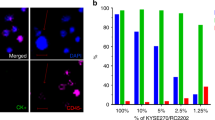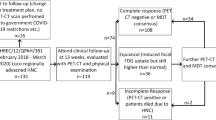Abstract
Background
Advancements in nasopharyngeal carcinoma (NPC) treatment have led to a focus on personalized treatment. Circulating tumor cells (CTCs) are important for liquid biopsies and personalized treatment but are not being fully utilized. This study examined how pre- and post-treatment CTC counts, EMT subtypes, clinical characteristics, and patient prognosis are related in order to support the use of liquid biopsy in managing NPC.
Methods
This retrospective study included 141 patients with locally advanced NPC. All patients underwent CanPatrol™ CTC detection pre- and post-treatment and were categorized into EMT subtypes: epithelial type, mixed type, and mesenchymal type. This study analyzed CTC enumeration, EMT subtypes, and their associations with clinical characteristics and survival outcomes.
Results
The results indicated a positive correlation between the pre-treatment detection rate of CTCs and N stage (P < 0.01), alongside a positive correlation with the TNM clinical stage (P = 0.02). Additionally, the detection rate of mesenchymal CTCs post-treatment is positively associated with the N stage (P = 0.02). The enumeration of CTCs pre- and post-treatment is negatively correlated with prognosis and has statistical significance. Additionally, an investigation into the EMT subtypes of CTCs revealed a significant association between the presence of mesenchymal CTCs pre- and post-treatment and decreased overall survival (OS) (P < 0.05). Furthermore, T stage, N stage, TNM clinical stage, and Epstein-Barr virus (EBV) DNA were also significantly correlated with OS.
Conclusion
The study found that mesenchymal CTCs pre- and post-treatment, as well as the number of CTCs, were linked to a poor prognosis.





Similar content being viewed by others
Data availability
Data for this study are available from the corresponding author upon reasonable request.
References
Chen Y-P, Chan ATC, Le Q-T, Blanchard P, Sun Y, Ma J (2019) Nasopharyngeal carcinoma. The Lancet 394:64–80. https://doi.org/10.1016/s0140-6736(19)30956-0
Chang ET, Ye W, Zeng Y-X, Adami H-O (2021) The evolving epidemiology of nasopharyngeal carcinoma. Cancer Epidemiol Biomark Prev 30:1035–1047. https://doi.org/10.1158/1055-9965.Epi-20-1702
He T, Yan R-N, Chen H-Y, Zeng Y-Y, Xiang Z-Z, Liu F et al (2021) Comparing the 7th and 8th editions of UICC/AJCC staging system for nasopharyngeal carcinoma in the IMRT era. BMC Cancer. https://doi.org/10.1186/s12885-021-08036-8
Xia W-X, Zhang H-B, Shi J-L, Lu X, Wang L, Ye Y-F et al (2013) A prognostic model predicts the risk of distant metastasis and death for patients with nasopharyngeal carcinoma based on pre-treatment serum C-reactive protein and N-classification. Eur J Cancer 49:2152–2160. https://doi.org/10.1016/j.ejca.2013.03.003
Pan JJ, Ng WT, Zong JF, Lee SWM, Choi HCW, Chan LLK et al (2016) Prognostic nomogram for refining the prognostication of the proposed 8th edition of the AJCC/UICC staging system for nasopharyngeal cancer in the era of intensity-modulated radiotherapy. Cancer 122:3307–3315. https://doi.org/10.1002/cncr.30198
Bossi P, Chan AT, Licitra L, Trama A, Orlandi E, Hui EP et al (2021) Nasopharyngeal carcinoma: ESMO-EURACAN Clinical Practice Guidelines for diagnosis, treatment and follow-up†. Ann Oncol 32:452–465. https://doi.org/10.1016/j.annonc.2020.12.007
Tang LL, Chen YP, Chen CB, Chen MY, Chen NY, Chen XZ et al (2021) The Chinese Society of Clinical Oncology (CSCO) clinical guidelines for the diagnosis and treatment of nasopharyngeal carcinoma. Cancer Commun 41:1195–1227. https://doi.org/10.1002/cac2.12218
Chen Y-P, Liu X, Zhou Q, Yang K-Y, Jin F, Zhu X-D et al (2021) Metronomic capecitabine as adjuvant therapy in locoregionally advanced nasopharyngeal carcinoma: a multicentre, open-label, parallel-group, randomised, controlled, phase 3 trial. The Lancet 398:303–313. https://doi.org/10.1016/s0140-6736(21)01123-5
Zhang Y, Chen L, Hu G-Q, Zhang N, Zhu X-D, Yang K-Y et al (2019) Gemcitabine and cisplatin induction chemotherapy in nasopharyngeal carcinoma. N Engl J Med 381:1124–1135. https://doi.org/10.1056/NEJMoa1905287
Sun Y, Li W-F, Chen N-Y, Zhang N, Hu G-Q, Xie F-Y et al (2016) Induction chemotherapy plus concurrent chemoradiotherapy versus concurrent chemoradiotherapy alone in locoregionally advanced nasopharyngeal carcinoma: a phase 3, multicentre, randomised controlled trial. Lancet Oncol 17:1509–1520. https://doi.org/10.1016/s1470-2045(16)30410-7
Nikanjam M, Kato S, Kurzrock R (2022) Liquid biopsy: current technology and clinical applications. J Hematol Oncol. https://doi.org/10.1186/s13045-022-01351-y
Alix-Panabières C, Pantel K (2021) Liquid biopsy: from discovery to clinical application. Cancer Discov 11:858–873. https://doi.org/10.1158/2159-8290.Cd-20-1311
Vasseur A, Kiavue N, Bidard FC, Pierga JY, Cabel L (2020) Clinical utility of circulating tumor cells: an update. Mol Oncol 15:1647–1666. https://doi.org/10.1002/1878-0261.12869
Galvis MM, Romero CS, Bueno TO, and Teng Y (2021) Toward a new era for the management of circulating tumor cells, reviews on new drug targets in age-related disorders. pp 125–134
Lowes LE and Allan AL (2018) Circulating tumor cells and implications of the epithelial-to-mesenchymal transition. pp 121–181
Friendlander AH, Ettinger RL (2009) Karnofsky performance status scale. Spec Care Dentist 29:147–148. https://doi.org/10.1111/j.1754-4505.2009.00088.x
Wu J, Zhu H, Gao F, Wang R, Hu K (2021) Circulating Tumor Cells: a promising biomarker in the management of nasopharyngeal carcinoma. Front Oncol. https://doi.org/10.3389/fonc.2021.724150
He Q, Zhou Y, Zhou J, Zhao D, Li L, Li X et al (2023) Clinical relevance of plasma EBV DNA as a biomarker for nasopharyngeal carcinoma in non-endemic areas: a multicenter study in southwestern China. Clin Chim Acta. https://doi.org/10.1016/j.cca.2023.117244
Siak PY, Khoo AS-B, Leong CO, Hoh B-P, Cheah S-C (2021) Current status and future perspectives about molecular biomarkers of nasopharyngeal carcinoma. Cancers. https://doi.org/10.3390/cancers13143490
Tan R, Phua SKA, Soong YL, Oon LLE, Chan KS, Lucky SS et al (2020) Clinical utility of Epstein-Barr virus DNA and other liquid biopsy markers in nasopharyngeal carcinoma. Cancer Commun 40:564–585. https://doi.org/10.1002/cac2.12100
Yang W-Y, Feng L-F, Meng X, Chen R, Xu W-H, Hou J et al (2020) Liquid biopsy in head and neck squamous cell carcinoma: circulating tumor cells, circulating tumor DNA, and exosomes. Expert Rev Mol Diagn 20:1213–1227. https://doi.org/10.1080/14737159.2020.1855977
Wen Z, Li Z, Yong P, Liang D, Xie D, Chen H et al (2019) Detection and clinical significance of circulating tumor cells in patients with nasopharyngeal carcinoma. Oncol Lett. https://doi.org/10.3892/ol.2019.10560
Xie X-Q, Luo Y, Ma XL, Li S-S, Liu L, Zhang H, Li P, Wang F (2019) Clinical significance of circulating tumor cells and their expression of cyclooxygenase-2 in patients with nasopharyngeal carcinoma. Eur Rev Med Pharmacol Sci. https://doi.org/10.26355/eurrev_201908_18735
Dongre A, Weinberg RA (2018) New insights into the mechanisms of epithelial–mesenchymal transition and implications for cancer. Nat Rev Mol Cell Biol 20:69–84. https://doi.org/10.1038/s41580-018-0080-4
Huang RY-J, Guilford P, Thiery JP (2012) Early events in cell adhesion and polarity during epithelial-mesenchymal transition. J Cell Sci 125:4417–4422. https://doi.org/10.1242/jcs.099697
Brabletz T, Jung A, Reu S, Porzner M, Hlubek F, Kunz-Schughart LA et al (2001) Variable beta-catenin expression in colorectal cancers indicates tumor progression driven by the tumor environment. Proc Natl Acad Sci U S A 98(18):10356–10361. https://doi.org/10.1073/pnas.171610498
Beerling E, Seinstra D, de Wit E, Kester L, van der Velden D, Maynard C et al (2016) Plasticity between epithelial and mesenchymal states unlinks EMT from metastasis-enhancing stem cell capacity. Cell Rep 14:2281–2288. https://doi.org/10.1016/j.celrep.2016.02.034
Ou G, Xing S, Li J, Zhang L, Chen S (2019) Circulating tumor cells: a valuable marker of poor prognosis for advanced nasopharyngeal carcinoma. Mol Med. https://doi.org/10.1186/s10020-019-0112-3
Qian Y, Wu Y, Yuan Z, Niu X, He Y, Peng J et al (2019) The frequency of circulating tumour cells and the correlation with the clinical response to standard chemoradiotherapy in locally advanced nasopharyngeal carcinoma: a prospective study. Cancer Manage Res 11:10187–10193. https://doi.org/10.2147/cmar.S222916
Gao T, Mao J, Huang J, Luo F, Lin L, Lian Y et al (2023) Prognostic significance of circulating tumor cell measurement in the peripheral blood of patients with nasopharyngeal carcinoma. Clinics. https://doi.org/10.1016/j.clinsp.2023.100179
Shibue T, Weinberg RA (2017) EMT, CSCs, and drug resistance: the mechanistic link and clinical implications. Nat Rev Clin Oncol 14:611–629. https://doi.org/10.1038/nrclinonc.2017.44
Byers LA, Diao L, Wang J, Saintigny P, Girard L, Peyton M et al (2013) An epithelial-mesenchymal transition gene signature predicts resistance to EGFR and PI3K inhibitors and identifies Axl as a therapeutic target for overcoming EGFR inhibitor resistance. Clin Cancer Res 19:279–290. https://doi.org/10.1158/1078-0432.Ccr-12-1558
Mittal V (2018) Epithelial mesenchymal transition in tumor metastasis. Annu Rev Pathol 13:395–412. https://doi.org/10.1146/annurev-pathol-020117-043854
Tsao SW, Tsang CM, Lo KW (2017) Epstein-Barr virus infection and nasopharyngeal carcinoma. Philos Trans R Soc B. https://doi.org/10.1098/rstb.2016.0270
Lee AWM, Lee VHF, Ng W-T, Strojan P, Saba NF, Rinaldo A et al (2021) A systematic review and recommendations on the use of plasma EBV DNA for nasopharyngeal carcinoma. Eur J Cancer 153:109–122. https://doi.org/10.1016/j.ejca.2021.05.022
Trevisiol C, Gion M, Vaona A, Fabricio ASC, Roca E, Licitra L et al (2021) The appropriate use of circulating EBV-DNA in nasopharyngeal carcinoma: comprehensive clinical practice guidelines evaluation. Oral Oncol. https://doi.org/10.1016/j.oraloncology.2020.105128
Hsu C-L, Chan S-C, Chang K-P, Lin T-L, Lin C-Y, Hsieh C-H et al (2013) Clinical scenario of EBV DNA follow-up in patients of treated localized nasopharyngeal carcinoma. Oral Oncol 49:620–625. https://doi.org/10.1016/j.oraloncology.2013.02.006
Yap K, Cohen EN, Reuben JM, Khoury JD (2019) Circulating Tumor Cells: state-of-the-art update on technologies and clinical applications. Curr Hematol Malig Rep 14:353–357. https://doi.org/10.1007/s11899-019-00531-x
Yu Y, Lin Z-X, Li H-W, Luo H-Q, Yang D-H, Zhou H-C et al (2020) Circulating tumor cells and fibronectin 1 in the prognosis of nasopharyngeal carcinoma. Technol Cancer Res Treat. https://doi.org/10.1177/1533033820909911
Li Y-J, Luo Y, Xie X-Q, Li P, Wang F (2018) The prognostic value of COX-2 expression on circulating tumor cells in nasopharyngeal carcinoma: a prospective analysis. Radiother Oncol 129:396–402. https://doi.org/10.1016/j.radonc.2018.07.022
Liu Z, Li L, Yang Z, Luo W, Li X, Yang H et al (2010) Increased expression of MMP9 is correlated with poor prognosis of nasopharyngeal carcinoma. BMC Cancer. https://doi.org/10.1186/1471-2407-10-270
Acknowledgements
The authors would like to thank all the patients, investigators, and institutions involved in this study.
Funding
This work was supported by grants from the National Natural Science Foundation of China (No. 71964003, 81460460, 81760542, 82260467), The Natural Science Foundation of Guangxi Zhuang Autonomous Region (No. 2018JJA141048).
Author information
Authors and Affiliations
Contributions
Conceptualization: Ting Liu, Chunmei Chen, Lihe He, Jing Liu; Methodology: Ting Liu, Guimei Wang; Formal analysis and investigation: Ting Liu, Guimei Wang; Writing—original draft preparation: Ting Liu, Chunmei Chen, Lihe He, Jing Liu; Writing—review and editing: Ting Liu, Chunmei Chen; Funding acquisition: Rensheng Wang; Resources: Rensheng Wang; Supervision: Ting Liu, Rensheng Wang, Chunli Ouyang.
Corresponding authors
Ethics declarations
Conflict of interest
The authors declare no conflict of interest.
Institutional review board statement
The study was conducted in accordance with the Declaration of Helsinki, and approved by the Ethics Committee of the First Affiliated Hospital of Guangxi Medical University (2024-E178-01, March 13, 2024).
Informed consent
All participants in the study received informed consent.
Additional information
Publisher's Note
Springer Nature remains neutral with regard to jurisdictional claims in published maps and institutional affiliations.
Rights and permissions
Springer Nature or its licensor (e.g. a society or other partner) holds exclusive rights to this article under a publishing agreement with the author(s) or other rightsholder(s); author self-archiving of the accepted manuscript version of this article is solely governed by the terms of such publishing agreement and applicable law.
About this article
Cite this article
Liu, T., Liu, J., Wang, G. et al. Circulating tumor cells: a valuable indicator for locally advanced nasopharyngeal carcinoma. Eur Arch Otorhinolaryngol (2024). https://doi.org/10.1007/s00405-024-08714-w
Received:
Accepted:
Published:
DOI: https://doi.org/10.1007/s00405-024-08714-w




